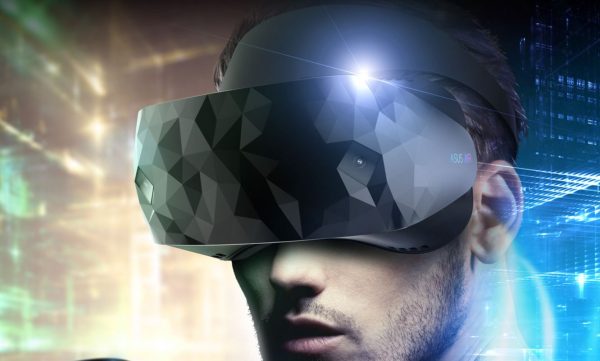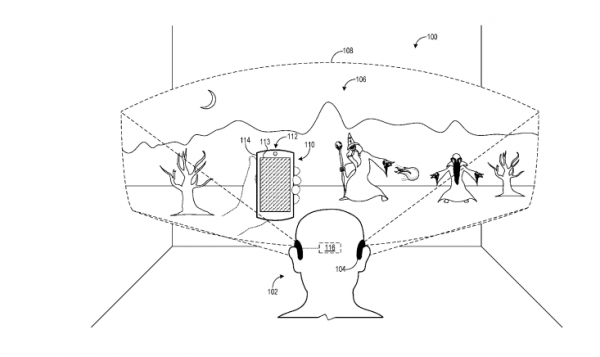Microsoft Brings Immersive Mixed Reality to Smartphones
Microsoft is envisioning a plan to merge Mixed Reality (MR) with smartphones to improve the experiences according to a new patent filed by the tech giant. The patent highlights Microsoft’s ambitious plan to bring users’ smartphones into Mixed Reality. This is coming hot on the heels of Microsoft’s recent announcement of its plans to launch the Microsoft HoloLens 2 headset during the MWC 2019.
The new patent highlights the multiple input methods that can be leveraged when the Mixed Reality technology is merged with smartphones in order to provide users with better quality interactions with the virtual reality environment, according to an article in the web portal MSPoweruser.

The article says that the VR experience can allow users to interact with virtual objects within a virtual experience and that there already exist a variety of input devices that can midwife such interactions such as the hand-held controllers that provide users with a rotational and translational input.
Apart from receiving inputs from the smartphone, Microsoft is also talking of the idea of expanding the virtual capabilities of the phone by adding a Mixed Reality overlay. In which case, the virtual reality experience could be a representation of the input device visually displaying device and giving the user an interface with both the device and virtual reality.

From the patent application, it is clear that Microsoft is exploring new ideas on how to incorporate both virtual reality and Mixed Reality into its future devices, particularly on its future smartphones.
While this is revolutionary, Microsoft isn’t the first tech company to wade into the possibility improving the Mixed Reality, Virtual Reality and Augmented Reality and then merging them into future smartphone devices.
Apple has also been active on the frontiers of this innovation. Its most recent act has been the publishing of the update “Systems, methods and graphical user interfaces for interacting with Augmented and Virtual Reality environments”. This update was added to a patent that Apple had filed in August of 2018.
Apple’s patent also shows its intention to build an AR-based headset that can work with the iPhone and allow users to access augmented reality experiences where images are overlaid into the real world.
Bringing Mixed Reality Software to Smartphones
In closely related developments, Microsoft has added Mixed Reality capabilities to its customer service and sales departments thereby extending these features to other applications beyond the HoloLens augmented reality headsets to smartphones.
Microsoft is also planning the release of the Dynamics 365 Product Visualize for iOS devices which make it possible for a variety of organizations in diverse industries and with complex products to visualize their products for their customers with the use of MR software on iOS devices. Possible use-cases for this can be in manufacturing, healthcare as well as the automotive industry.
The company announced in a February 21 news release that it is also planning on releasing the Dynamics 365 Remote Assist for Android products. The Product Visualize helps enterprises to showcase products to customers while the Remote Assist will help organizations’ field service agents in collaborating with colleagues working remotely and also in troubleshooting any service problems that may occur in the course of working with the mixed reality software.
The two products, Remote Assist and Product Visualize, will be released for preview in April this year. The pricing and packaging information for the two products have not yet been divulged.
Microsoft’s other product, the HoloLens, already offers users these capabilities. However, Microsoft is moving these to the mobile devices with the aim of spurring end users to adopt the technology and take it mainstream. In spite of the buzz, the uptake is still too low. In a recent Forrester survey, only 7% of respondents said they use their smartphones for VR and AR apps every week and only 3% use these apps on a daily basis. On the other hand, the tablet usage rate is a bit higher with about 11% of respondents saying they use the AR and VR apps weekly and 5% on a daily basis. But interest in the technologies is strong. Some 43% of US business users admitted in the same Forrester survey that they are interested in learning more about virtual reality and another 39% is interested in taking VR-specific training.
The customer service aspect is also coming in handy at a time when many customer service software vendors across the globe are beginning to take augmented reality ad mixed reality more seriously and integrating them into their service software products thereby providing end users with more options to interact with their clients.
Across disparate industries, there is an increasing realization that these tools will be crucial to enhancing performance and ease of doing business across various departments including sales, manufacturing, customer support, supply chain management, product design and manufacturing.
https://virtualrealitytimes.com/2019/03/02/microsoft-brings-immersive-mixed-reality-to-smartphones/https://virtualrealitytimes.com/wp-content/uploads/2019/03/Microsoft-envisions-expanding-your-phone-features-by-adding-mixed-reality-overlays-600x428.jpghttps://virtualrealitytimes.com/wp-content/uploads/2019/03/Microsoft-envisions-expanding-your-phone-features-by-adding-mixed-reality-overlays-150x90.jpgBusinessMicrosoftMicrosoft is envisioning a plan to merge Mixed Reality (MR) with smartphones to improve the experiences according to a new patent filed by the tech giant. The patent highlights Microsoft’s ambitious plan to bring users’ smartphones into Mixed Reality. This is coming hot on the heels of Microsoft’s recent...Sam OchanjiSam Ochanji[email protected]EditorVirtual Reality Times - Metaverse & VR
